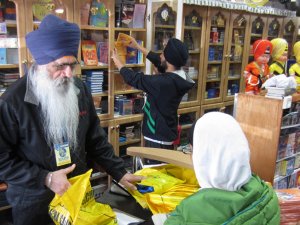Guru Nanak’s perspective on humanity is larger than life; expansive and timeless. More important than any historical nuggets are the impactful events of his meaningful life. In a lifespan of about 70 years, Nanak married, sired two sons, traveled widely across much of the known world of his times, and was a successful working farmer. Today, a worldwide ever-growing circle of more than 25 million Sikhs and non-Sikhs swear by his message.
Rather than a paean (a joyful hymn of praise) to Guru Nanak, the man and the prophet, I aim to explore the transformative agenda he gifted us – its meaning and purpose.
Ground realities in Punjab and India when Nanak was born
Religions alone cannot always hold a nation together. Bangladesh was created out of Pakistan. Both are Muslim nations but their 24-year-old union collapsed in 1971. In the Middle East; almost all nations are predominantly Muslim, and they are mostly at loggerheads with each other. Sunni and Shia Muslims hate each other. Sephardic and Ashkenazi Jews are not too fond of each other. Christian history provides instructive details of internal frictions and travails of the various sects.
India is somewhat like Europe. It was never a single unified nation except under the British and the Mughals. Ergo, invaders could dominate India with only limited manpower. India was then a mélange of independent or quasi-independent nation states, each with a distinct culture, language, cuisine, music and ethos. Since 1947 it is a politically unified nation as it was under colonial masters, but the fragmentation persists.
When Guru Nanak appeared 550 years ago India was ruled ruthlessly by Muslim invaders bent on converting natives at the point of a sword, if necessary. Hindu society, despite its noble antecedents, was hamstrung by a decadent divisive religious culture, a reprehensible caste system that exists even today, and the shamefully degraded place of women. A divided society that had lost its moral compass, often willing to sell out to invaders. This is what the young Nanak saw.
What do a People Need?
How do a people reclaim their own humanity and dignity? The hope that tomorrow will be better than today has prerequisites for its flowering: Freedom of speech and action, participatory self-governance with transparent accountability, security, economic progress, infrastructure and an ethical code for a productive life.
Easier said than done! Two choices surface: Evolution or revolution. Revolutions are bloody. They may change rulers but not as easily the mindset of a people. Our mindset is a product of long-standing intergenerational and culturally ingrained habits of the heart, traditions that define the self; in other words, the paradigm or the default position of the mind. Lasting paradigm shifts demand time that transcends generations
A transformative paradigm shift is exactly what Guru Nanak launched, and it took a good ten generations — almost 240 years — to mature and bear fruit in its modern form. As expected, the path was mine-laden. Muslim rulers, with the connivance of some Hindu rulers went on the warpath to defend their politico-religious dominance. Hindus saw Sikhi as undermining their hold on the people with a challenging new ideology that rejected their timeless but backward teachings on caste, place of women, idol worship and similar practices that divided and weakened the people.
The first step in the endeavor was the creation of community of the dispossessed people. Nanak started a kitchen (langar) where people of all castes would come together, prepare and serve food to all — irrespective of caste, creed, color or gender. Enjoy a meal, listen to uplifting poetry and teachings with music (keertan) and relate to each other as equals. Remember that in the traditional society high and low castes would never mingle or break bread together. Nanak rejected food taboos and dismissed the notion that high and low caste people may not intermix. People had to learn how to live with each other, not caring if they were sharing time with a king or pauper, a Brahmin or an untouchable. In India at that time, this was revolutionary.
Guru Nanak’s teaching begins with a revolutionary alphanumeric of his own design — Ik Oankaar — he proclaimed. Ik stands for the number One; Oankaar, rooted in Sanskrit, speaks of the Creator/Creation. If one can see the Oneness of the Creator/Creation, there is then no room left for a sectarian separate Jewish, Christian, Hindu, Muslim Sikh, Brand X, or any other form of the Creator, because that would be a lesser god, not worthy of worship. Guru Nanak’s Creator has no physical form and transcends all physical descriptions. This infinite reality by definition can never be captured by our human finite mind and vocabulary.
This profound message framed the fundamentals of a productive meaningful life in the language of the people — norma loquendi — as poetry to be musically rendered. Why? Because, at best, the spoken message settles in the head (home of the intellect) music takes the message to the heart (home of the soul.) Poetry is chock full of allegories, analogies and similar devices to hold the mind. The compositions used the classical timeless Raga system of Indian musicology. Music and poetry are thus experienced, internalized and interpreted, not literally rendered.
Guru Nanak, accompanied by a Muslim musician, Mardana, took his message across the known world of that time well beyond Punjab and India.
Did Nanak want to start a new faith system?
I am sure he did. Guru Nanak traveled through India, modern Pakistan and beyond — South to Sri Lanka, North to Tibet, East beyond Assam and West to Afghanistan, Mecca, Turkey and neighboring countries, including perhaps China, as well. (Historical depictions remain somewhat vague) He held dialogues with scholars and others of many faiths. After four odysseys, he returned to Punjab and founded Kartarpur, now in Pakistan, as the Sikh model of Utopia where he nurtured the first Sikh community. Kartarpur became a bustling presence with businesses and traders. The community prospered. Guru Nanak lived there with his wife and two sons, taught the Sikh way of life and tilled his farm side-by-side with his Sikhs.
Kartarpur, was a defining step forward towards development of economically viable infrastructure for a people. Note that it was not near any Hindu or Muslim religious center. Never in his many years did Guru Nanak ever recommend that Sikhs go to a Hindu or Muslim place of worship. The gurduara (Dharamsal) at Kartarpur was the community’s only hub and place of worship.
If Guru Nanak’s purpose had been only to reform Hinduism and stay within its embrace without creating a new faith discipline, he would not have needed to travel so widely nor highlight the distance between Sikh and Hindu or Muslim practices. If he entered a Hindu or a Muslim place of worship it was not to join the rite but to impart a lesson and reform an existing practice.
Passing the Torch
Think a moment: If a business, or shop closes its doors at the death of the founder it is a failed venture. An enterprise must continue past the generations to earn the sobriquet of an institution or movement.
How do you rebuild a nation and its people diminished by centuries of invasions and destruction? Keep in mind that a massive transformative task is not completed in hours, days, months or even years. There are many dots to connect. Many life models, habits of the heart or paradigms need to be minutely re-explored, tweaked, modified, even jettisoned and replaced. Never an easy process, a paradigm shift is called for. Habits of the heart are never easy to reform or displace.
Guru Nanak’s message continued and was further developed by his nine successors. Guru Nanak lived centuries ago. Times change; newer questions surface. Sikh institutional development continued under Nanak’s successor Lehna, who became Guru Angad, and progressed through a total of ten Gurus; significantly, each wrote under the name and authority of Nanak.
Guru Angad moved his activities to a new settlement – Khadur Sahib. And now there were two urban centers flourishing in Punjab. Guru Angad also systematized the rules of Gurmukhi, the written script of the Punjabi language.
Amardas, the third Guru, chose Goindwal as his base of operations. His presence attracted businesses, creating a third Sikh community without diminishing the luster of Kartarpur and Khadur Sahib. In order to upend the injustice to women, he appointed them to leadership positions in spreading the message of Sikhi; encouraged widows to remarry and condemned the horrendous practice of satee – self-immolation by widows. He also started the tradition of twice-yearly conclaves of Sikhs, somewhat like modern Town Halls, to reconnect with the teachings and confer on current issues that might affect the community.”
Guru Ramdas followed. He founded Ramdaspur that became Amritsar. It remains, over 400 years later, the largest, most important commercial, cultural and educational hub of Punjab. It defines, through its history, the Sikh psyche today.
Guru Arjan compiled writings of the previous four Gurus, along with his own, added compositions of a few selected Hindu and Muslim saints and poets whose views resonated with Sikh teachings, and installed the compilation as the first rendition of Sikh scripture (Adi Granth) in 1604. This became the authoritative document on Sikh ethos. The Harimandir (Golden Temple,) located in Amritsar, has been the de-facto capital of all Sikh activities, social, educational, administrative or political, whether local or international, since that time; Guru Arjan, the fifth Guru, completed its development. He was the first Sikh martyr in the cause of freedom of religion. The lesson: One must learn to die before one may pick up a weapon.
Guru Hargobind continued to mentor Sikh development. Over the 100 years since Guru Nanak, much had changed. Islam had become aggressively fanatic. The Sikh movement had acquired heft and visibility, and continued to emphasize peaceful coexistence with other faiths. Guru Nanak had taught that the Creator is not found in seclusion, ascetism or renunciation but within the active worldly life – the two are not mutually exclusive. Now Guru Arjan had been martyred. So, Guru Hargobind, the sixth Founder-Guru formally enunciated the doctrine of Meeri-Peeri that emphatically merges the internal spiritual life of worship, prayer and the mind with the outwardly directed worldly pursuit of action. These two primary fundamentals of Sikh existence must never be sundered. Sikhs are to be peaceful and non-violent but not pacifist. So, Guru Hargobind wore two swords – the sword of Meeri and the sword of Peeri. This recognizes that a successful life in the human domain is a life of action (Meeri) but never torn asunder from its spiritual foundations and values (Peeri.) One without the other remains incomplete. He raised a militia to counter armed warfare thrust upon him. Each subsequent Guru maintained an armed militia. Guru Hargobind also built the townships of Hargobindpur, Mehraj and Kiratpur, and even a mosque for the many Muslims who were attracted to Sikhi but remained Muslims. Briefly, the doctrine of Meeri-Peeri and the Akal Takht (undying throne) that he defined and built are at the core of nation building and critical to Sikh history and Sikh values.
Guru Har Rai who followed and helped clarify doctrinal matters, was dedicated to ecological concerns and created resources, remedies and medicaments for the needy. Guru Harkrishan served very briefly, from age five until age 8, when he left his physical form) and is remembered for service to the poor during a horrendous smallpox epidemic.
The towns of Anandpur and Paonta Sahib are associated with Guru Tegh Bahadur. But this ninth Guru lives in our memories for accepting martyrdom to assert the fundamental right of religious freedom – for Hindus to refuse conversion to Islam under duress. Guru Tegh Bahadur himself was not a Hindu. The underlying principle here (often misattributed to Voltaire) remains that “I disapprove of what you say, but I will defend to the death your right to say it.”
The saga of Guru Gobind Singh deserves many books, much more than the brief paragraph here. In 1699 he brought the transformative change started by Guru Nanak to its mature modern form. He created the community of Khalsa that changed the face of Punjab and India into a free outer directed people at peace with their inner self (Remember the underpinnings of Meeri-Peeri that must remain in sync.) Guru Gobind Singh also added Guru Tegh Bahadur’s compositions and prepared a final recension of the Adi Granth that he installed as the Guru Granth.
In the two centuries from Guru Nanak to Guru Gobind Singh, Sikhi had come a long way. Guru Gobind Singh further saw that his Sikhs had now earned self-governance. He decreed, therefore, that henceforth, in Sikh practice the Guru Granth remains the repository of all Sikh spiritual heritage while temporal authority would rest in the Sikh community acting in awareness of the spiritual heritage that defines and guides them.
Soon after Guru Gobind Singh in early 17th century, Sikhs had evolved the traditions of Sarbat Khalsa where community representatives would gather in conclaves — like town hall meetings that you see across the world today — to debate and discuss issues of peace and war or critical turns in direction that face us. Also, matters like traditions, Code of Conduct (Rehat Maryada), protocols and related Constitutional matters may be revisited as needed.
These systems exist, but they have been corrupted by neglect, human inertia and perhaps some questionable intentions. As with any path, it is important to know where we are at a given point, but even more critical is the trajectory of the path. Only then, as Sikhi promises, the journey becomes the destination. A continuing exploration is necessary so that we don’t throw away the baby with the bath water. The onus is ours.
My mandate today was to delineate the borders of Guru Nanak’s mission. My heartfelt plea is that you see Guru Nanak, unusual and special as he surely was, as the one who founded and shaped our journey — a revolutionary movement — that still tugs at us today. There can be no better legacy.
The process won’t be easy but it is so essential. The journey started with Guru Nanak and we celebrate him. It does not end with his mortal life or with ours.






